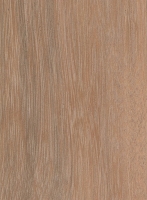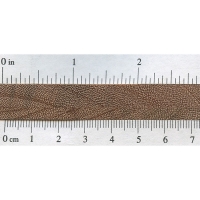 |
Common Name(s): Mora
Scientific Name: Mora excelsa, M. gonggrijpii Distribution: Northeastern South America (primarily Guyana and Suriname) Tree Size: 100-130 ft (30-40 m) tall, 2-3 ft (.6-1.0 m) trunk diameter Average Dried Weight: 63 lbs/ft3 (1,015 kg/m3) Specific Gravity (Basic, 12% MC): .80, 1.01 Janka Hardness: 2,300 lbf (10,230 N) Modulus of Rupture: 22,550 lbf/in2 (155.5 MPa) Elastic Modulus: 2,790,000 lbf/in2 (19.24 GPa) Crushing Strength: 11,950 lbf/in2 (82.4 MPa) Shrinkage: Radial: 6.7%, Tangential: 9.9%, Volumetric: 17.7%, T/R Ratio: 1.5 |
Color/Appearance: Heartwood is light to medium reddish brown. Wide pale yellow-brown sapwood is clearly demarcated from heartwood.
Grain/Texture: Has a straight to interlocked grain, with a medium to coarse texture. Good natural luster.
Endgrain: Diffuse-porous; large pores in no specific arrangement, few; solitary and radial multiples of 2-3; heartwood deposits present; narrow rays faintly visible without lens, normal spacing; parenchyma vasicentric,lozenge, winged, confluent, and marginal.
Rot Resistance: Mora is rated as durable to very durable, and also has good resistance to insect attacks.
Workability: Pieces with interlocked grain can be difficult to work, frequently resulting in tearout during machining operations. Mora also has a pronounced blunting effect on cutting edges.
Odor: Mora can have an unpleasant and sour odor while being worked.
Allergies/Toxicity: Mora has been reported to cause respiratory irritation. See the articles Wood Allergies and Toxicity and Wood Dust Safety for more information.
Pricing/Availability: Mora is used within its native range, and is only occasionally exported. When available, prices should be moderate for an imported hardwood.
Sustainability: This wood species is not listed in the CITES Appendices or on the IUCN Red List of Threatened Species.
Common Uses: Flooring, boatbuilding, heavy (exterior) construction, and turned objects.
Comments: Not to be confused with a striped Guatemalan wood that is also sometimes marketed as “Mora,” which is almost universally mislabeled as Maclura tinctoria. Mora excelsa can be distinguished by a more uniform and consistent color, as well as a coarser texture and an unpleasant sour odor when being worked.
None available.
Scans/Pictures:
 |
 |
 |
 |





common name should be added these following names: Eastern mahogany, Nato.
I second this. This wood, termed “nato” has become extremely common as a kind of a mahogany substitute in less expensive guitars, particularly for the neck and sides. I’ve also seen it claimed that nato is nyatoh, but the mora claim seems more convincing: https://en.wikipedia.org/wiki/Nato_wood
Nyatoh has very close Specs as Khaya.
Which makes Sapele seem light. Has anyone been chagrined and completely baffled by the absolute carelessness of Music retailers as well as the self proclaimed tone wood pundits that call Mora aka nato… Nyatoh ?!?! If Mora was used on a guitar body it would be close to the weight and hardness of, say Bubinga or …
Nato wood is a general term for wood from Mora trees. The best-known species are Mora excelsa (mora) and Mora gonggrijpii (morabukea). This should not be confused with nyatoh, an Asian hardwood from the family Sapotaceae with a very similar look and characteristics to Honduras mahogany, though totally unrelated